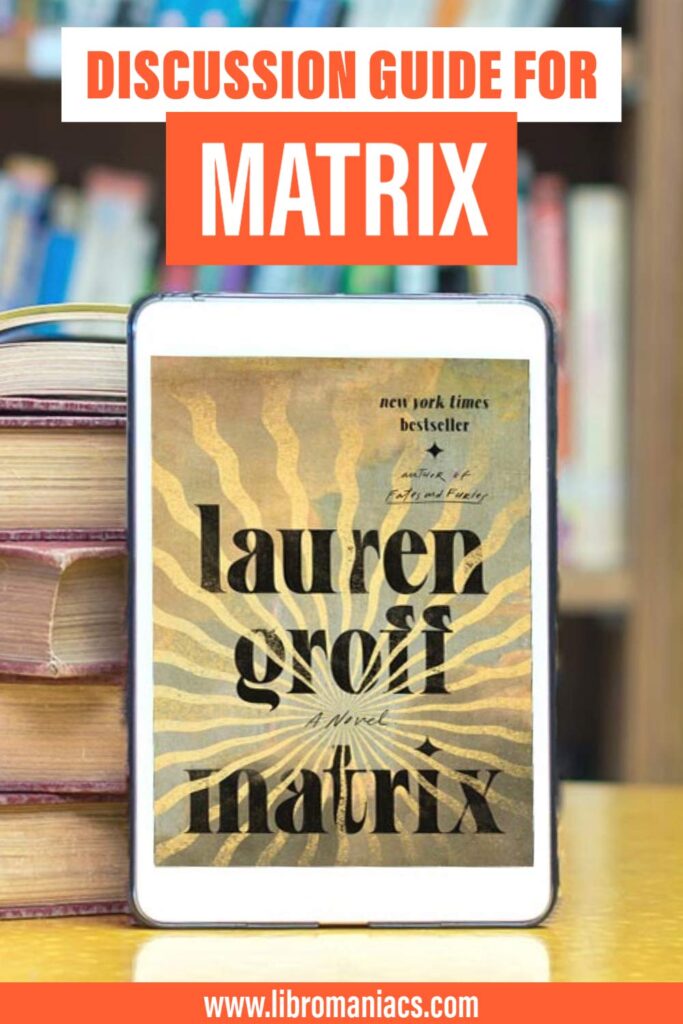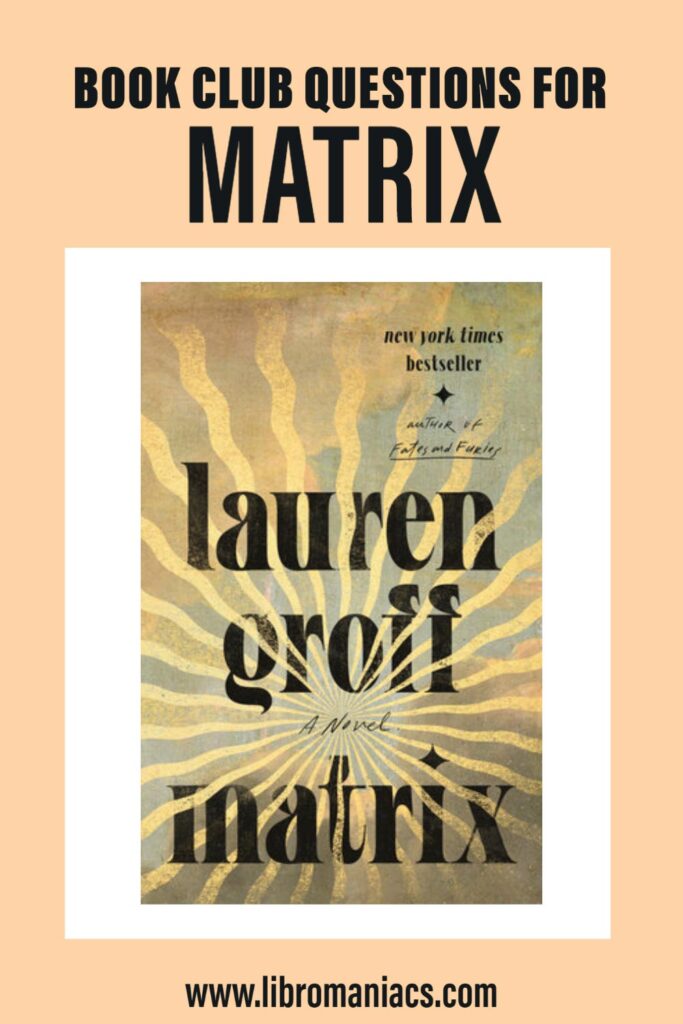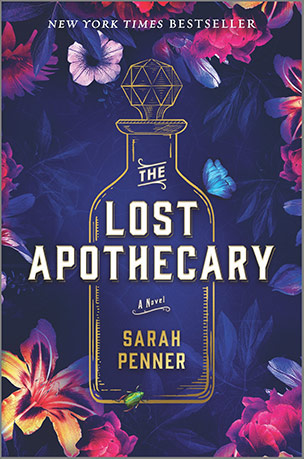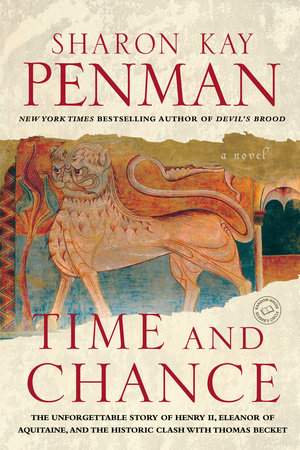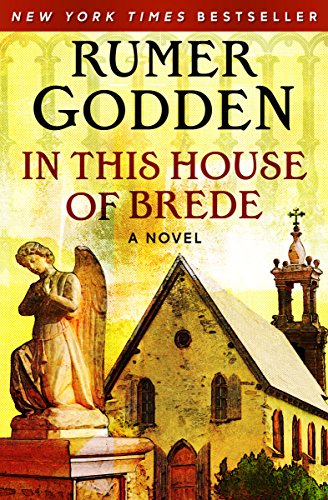Lauren’s Groff’s imagination is certainly not on auto-pilot. Her growing body of work is creative and thought-provoking. She builds her skills with each subsequent work, but she’s not content to stay in one lane. And with Matrix, she definitely swerved her work down an entirely new road.
We weren’t expecting her to come up with an angry, ambitious, lesbian-leaning nun with large feet, but that’s what she delivered to us. And this is why Matrix is so ripe for a book discussion. Our Matrix book club questions will help you and your group unpack the book’s complex themes, which include: the nature of power, subduing nature, gender roles, self-sufficiency, resistance and faith vs agency.

(This article contains affiliate links. This means that if you choose to purchase, I’ll make a small commission.)
Matrix Synopsis
Matrix, by Lauren Groff
(This book was a National Book Award finalist)
Cast out of the royal court by Eleanor of Aquitaine, deemed too coarse and rough-hewn for marriage or courtly life, seventeen-year-old Marie de France is sent to England to be the new prioress of an impoverished abbey, its nuns on the brink of starvation and beset by disease.
At first taken aback by the severity of her new life, Marie finds focus and love in collective life with her singular and mercurial sisters. In this crucible, Marie steadily supplants her desire for family, for her homeland, for the passions of her youth with something new to her: devotion to her sisters, and a conviction in her own divine visions. Marie, born the last in a long line of women warriors and crusaders, is determined to chart a bold new course for the women she now leads and protects. But in a world that is shifting and corroding in frightening ways, one that can never reconcile itself with her existence, will the sheer force of Marie’s vision be bulwark enough?
Equally alive to the sacred and the profane, Matrix gathers currents of violence, sensuality, and religious ecstasy in a mesmerizing portrait of consuming passion, aberrant faith, and a woman that history moves both through and around. Lauren Groff’s new novel, her first since Fates and Furies, is a defiant and timely exploration of the raw power of female creativity in a corrupted world.
10 Matrix Book Club Questions
- Our first Matrix book club question is about the title itself? There is a quote from the book referring to Eve’s taste of the fruit of knowledge, that “without the womb of Eve, which is the House of Death, there could be no womb of Mary, which is the House of Life. Without the first matrix, there could be no salvatrix, the greatest matrix of all.”
Matrix is an archaic term for womb. But it can also mean a point of origin, a grid, aggregate materials, or a casting mold. So, what then, did Groff intend by using Matrix in the title? - Groff has said that she wrote Matrix as a contemporary novel, even though it’s set in the 12th century. Pluck out a few of the novel’s themes and discuss how they have relevance in the present day. Or, put another way, in what way is Marie an anomaly of her time and how might she be more accepted and at home in our current society?
- “The song rises from the mouths of the nuns in puffs of white breath, it expands as it flies, it touches the tall white ceiling and collects there until it grows so heavy that it begins to pour down the walls and the pillars and the windows in a cascade”. What did you think of Groff’s descriptive writing style. Were there some particular passages that really stuck with you?
- When Marie arrives, the nuns are sick and starving. One of the ways that Marie manages the turnaround is to assign work according to each nun’s aptitude. Compare that with the decision of the previous Abbess, who would assign work at which nuns were inept, for the express purpose of teaching them humility. Discuss the pros and cons of each approach.
- “…she will never again allow anyone but a woman to set foot here.” The labyrinth as the most elaborate barrier that the Abbey constructed to protect themselves, but Marie instigated other isolation strategies as well. Were they strictly necessary? How might the Abbey evolved if it had not been so isolated? What were some consequences of that isolation?
- Marie’s early relationship with Eleanor was clearly that of a subject to her Queen. But over the decades they come to counsel one another. Discuss Marie’s relationship with Eleanor and the ways that it does (or doesn’t) evolve over the course of the book.
- Some of the other nuns resist Marie’s more radical ideas. Goda and Wevua in particular act as ballast. How do they attempt to check Marie’s power throughout the book? Are they successful in doing so?
- At the beginning of the novel, Marie is angry and up for a fight. But toward the end of her life she says “open your hands and let your life go. It has never been yours to do with what you will”. How does Marie evolve as a person throughout the book?
- Marie has a series of visions which present ideas and inspiration, such as for the protection or expansion the Abbey. Is she a mystic? Are these visions truly religious in nature, or is she simply having a heated moment of clarity?
- And on that note, what did you think of her final vision? In it she sees that God has “laid the goodness in the world with her eggs” (emphasis mine).
Selected, Thought Provoking Reviews of Matrix
“Marie’s story is a story about the power of women and womanhood. The love they can have for and nurture in one another. It takes the position that freed from men, and societal expectations, women can flourish into their best selves.”
“…a medieval abbess is a challenging heroine — living, as she does, a millennium away from us, suspended in that dim historical period long after the Romans but centuries before Shakespeare. We need a trusted guide, someone who can dramatize this remote period while making it somehow relevant to our own lives. Groff is that guide largely because she knows what to leave out. Indeed, it’s breathtaking how little ink she spills on filling in historical context.”
“I would venture to add that the less one knows of Marie de France and her writings, the easier it might be to fall into this book. In fact, the hook of ‘Marie de France’ is precisely that, a hook on which to hang a story that could have been about any modern fantasy of a powerful medieval woman’s life – it doesn’t really touch base with what we learn about the real Marie from her writings…”
“…Groff’s casual conflation of two historical characters on the basis of a shared given first name (Marie of France, a contemporary but very different woman than Marie d’Anjou) seems a bit out of line even in fiction. It seems to me the book is much more a feminist polemic. It is obviously a vision of a feminine utopia, a Shakerism without the men anywhere in sight, and contentedly gay.”
3 Books Like Matrix
If you want more female-power or books that poke at the notion of “a woman’s place”, you can recommend, read and then use our book club guides for Girl, Woman, Other, City of Girls, Outlawed and Erotic Stories for Punjabi Widows. And below you’ll find a few suggestions that key on other themes of Matrix.
The Lost Apothecary, by Sarah Penner
If you’d like more of historical women using their power to rail against the baser needs of men, then this book is for you. It’s a mix of contemporary and historical fiction. The historical sections of the book are set in 1791. The Apothecary at the center of the story runs a dark business, secretly dispensing poisons in order to help liberate women from the lovers and husbands who have wronged them.
Read it for book club and use our discussion guide for The Lost Apothecary.
Time & Chance, by Sharon Kay Penman
This book gives you more of Eleanor of Acquitaine. It’s the second in the Plantagenets series, which Penman has written about Eleanor of Aquitaine and Henry II’s rein. It covers the period from 1156 to 1171. There’s a lot in there about Henry’s attempts to hold on to land. But a significant portion of the book is devoted to Henry and Eleanor’s fraught marriage and the consequences for their power when it begins to fray.
In This House of Brede, by Rumer Godden
Want more nuns? Then try this portrait of Philippa Talbot, who left a comfortable London life to join a cloistered Benedictine community. The book offers a lot of detail about the lives and often very human frailties of the nuns who live there. The book has a clear focus “…on the ways people can change when they are determined to do it. A real look at the examined life and the community formed by a group of diverse personalities with a shared world view.”
Share these Matrix book club questions on Pinterest:
